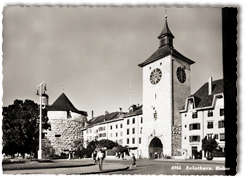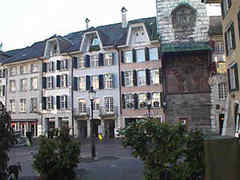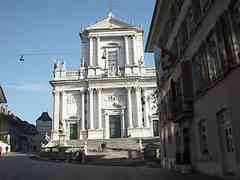 |
|
|
It is hardly surprising that there are not less than three names for this town steeped in tradition on the banks of the Aare. It is the capital of the canton with the same name and harmoniously combines Italian grandeur with French charm and German Swiss stability. Gates, towers and gables testify of its old traditions. Solothurn's reputation as Switzerland's best-preserved and most beautiful baroque town is well earned. The writer Carl Spitteler as the „fabulous city of golden roofs“ has indeed described it. Solothurn is one of the oldest towns north of the Alps.
The legendThere is even a legend that our ancestors watched from the mighty wall God create Earth and that they found it wanting. Legend it may be, but here between the Jura mountain range and the River Aare, hunters were already settled in the Neolithic age. The name Solothurn is of Celtic origin: Saloduron means the "stronghold of the Salos". Around 370 A.D. the Romans built a fort here; there are still traces of it today. As the northern corner stone of the Burgundian kingdom, Solothurn received an influx of new blood in the 10th century. But it was the presence of the ambassadors sent by the French Kings (1530-1792) and of the rich and ruthless mercenaries, which brought Solothurn fame, prosperity and the appropriate name of "Ambassadorial Town". It is definitely worth taking a stroll through the traffic-free old city, following in the footsteps of the ambassadors.
Solothurn is unique but has eleven of everythingSacred memorials of European significance, such as the Cathedral of St Ours or the Jesuit church, are set close together. Near them are the residences of the old ruling families, decorated burghers' houses strong fortifications, beautiful fountains surmounted by statues and the imposing "Landhaus". However there is more to Solothurn than just ancient monuments. It throbs with life, a dynamic city where people live, work and trade. There is a market in the narrow streets every Wednesday and Saturday where the farmers of the region offer flowers, fruit and vegetables for sale, just like in the olden days. There are plenty of teashops, with a relaxed, friendly atmosphere. Restaurants and street cafes abound. After a stroll through the town you may decide to have a meal literally inside the city walls. Another thing: ask a local resident about the "holy Solothurn number 11" and you will learn that in 1481 Solothurn became the eleventh canton to join the Swiss confederation and that appropriately enough there are eleven of everything in the town: eleven churches and chapels, eleven historic fountains and eleven towers. It is no wonder that the cathedral of St Ours has eleven altars and eleven bells and that its imposing staircase leading down from the main door is made up of flights of eleven steps. Perhaps those you talk to will show you some of these interesting sights. "Visitors welcome" is no meaningless expression in Solothurn. And you will see for yourself that although many things are to be found eleven times over, Solothurn itself is unique.
A small town with a wide choice of cultural activitiesSolothurn is small, with a population of only 16,000, but its range of culture is very wide. For example there is the Ensemble Theatre, the Solothurn Film and Literature Festivals, frequent concerts, exhibitions at local art galleries and theatrical performances in a number of small theatres. There are outstanding things to be seen in Solothurn's museums: the Fine Art Museum has a good collection of post-1850 Swiss art and another of old masters. Don't miss the fascinating "Virgin with Strawberries" (circa 1425) or the "Solothurn Madonna" (1522) by Hans Holbein the Younger. The Natural History Museum is one of the most modern buildings in Switzerland and is outstanding by international standards. Children in particular should not only see but also touch and "experience" the exhibits. One of Europe's largest collections of weapons can be seen in the Old Arsenal ("Altes Zeughaus") Museum. 400 suits of armour recall the tumultuous times of the mercenaries. The Blumenstein Museum shows us how the ruling class used to live. There is much here to interest students of ancient history. In addition there is the Treasury of the Cathedral of St Ours, a museum in memory of the Polish freedom fighter and hero Tadeusz Kosciusko and also the Kreuzen Stone Museum.
The Solothurn RegionThe Solothurn region has an exceptional range of facilities: openair and indoor swimming pools, tennis and squash courts, mini golf courses with saunas and solariums, indoor ice rinks and a riding school as well as special paths for cycling and walking and keep-fit obstacle course, amongst other things. Solothurn is also an ideal starting point for excursions. From here you can go all over Switzerland: the Lake of Biel, the Bernese Oberland, the Emmental and Central Switzerland are within easy reach. Bern, Basel, Lucerne, Zurich and Neuchatel are all only an hour away. And when you return from your expedition we'll be glad to welcome you back to Solothurn. |



